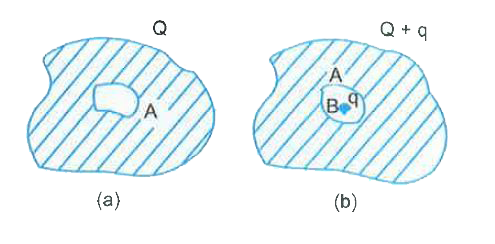(a) A conductor A with a cavity as shown in Fig, is given a charge Q. Show that the entire charge must appear on the outer surface of the conductor.
(b) Another conductor B with charge q is inserted into the cavity keeping B insulated from A. Show that the total charge on the outside surface of A is (Q+q) fig.
(c) A sensitive instrument is to be shielded from the strong electrostatic field in its environment. Suggest a possible way.

a) Let us consider a Gaussian surface that is lying wholly within a conductor and enclosing the cavity. The electric field intensity E inside the charged conductor is zero.
Let q is the charge inside the conductor and ε0 is the permittivity of free space
According to Gauss’s law,
ϕ=¯¯¯E.¯ds=qε0
flux,
Here, E=0
qε0=0
∴ε0≠0
∴q≡0
Therefore, charge inside the conductor is zero. The entire charge Q appears on the outer surface of the conductor.
(b) The outer surface of conductor A has a charge of amount Q. Another conductor B having charge +q is kept inside conductor A and it is insulated from A. Hence, a charge of amount −q will be induced in the inner surface of conductor A and +q is induced on the outer surface of conductor A. Therefore, total charge on the outer surface of conductor A is Q + q.
(c) A sensitive instrument can be shielded from the strong electrostatic field in its environment by enclosing it fully inside a metallic surface. A closed metallic body acts as an electrostatic shield.
Topper's Solved these Questions
- ELECTRIC CHARGES AND FIELDSBook:NCERT ENGLISHChapter:ELECTRIC CHARGES AND FIELDSExercise:Exercise
Explore 34 Videos
- DUAL NATURE OF RADIATION AND MATTERBook:NCERT ENGLISHChapter:DUAL NATURE OF RADIATION AND MATTERExercise:All Questions
Explore 32 Videos
- ELECTROMAGNETIC INDUCTIONBook:NCERT ENGLISHChapter:ELECTROMAGNETIC INDUCTIONExercise:Exercise
Explore 17 Videos
Similar Questions
(a) A conductor A with a cavity as shown in Fig, is given a charge Q. Show that the entire charge must appear on the outer surface of the conductor.
(b) Another condutor B with charge q is inserted into the cavity keeping B insulated from A. Show that the total charge on the outside surface of A si (Q+q) fig.
(c) A sensitive instument is to be shielded from the strong electrostatic field in its enviroment. Suggest a possibe way.

View SolutionA conductor A with a cavity as shown in is given a charge Q. show that the entire charge must appear on the outer surface of the conductor.

Another conductor B with charge q is inserted into the cavity keeping B insulated from A. Show that the total charge on the outside surface of A is Q+q
(c) A sensitive instrument is to be shielded from the strong electrostatic fields in its environment. Suggest a posible way.
View Solution
Knowledge Check
Work done in moving a charge q coulomb on the surface of given charged conductor of potential V is
AVq jouleBVq jouleCqV jouleDZeroThere is a conductor with cavity of radius R as shown in figure. A point charge Q is placed at R/2 distance from centre of cavity.
A point P is at r distance from centre of conductor. Then,
 Acharge density at iner surface of cavity will be non uniformBcharge density at surface of conductor will be uniformCelectric field at point P is Q4πε0r2Dforce on charge Q is non zero
Acharge density at iner surface of cavity will be non uniformBcharge density at surface of conductor will be uniformCelectric field at point P is Q4πε0r2Dforce on charge Q is non zeroAn ellipsoidal cavity is carved within a perfect conductor. A positive charge q is placed at the centre of the cavity. The points A and B are on the cavity surface as shown in the figure. Then
 Aelectric field near A in the cavity = electric field near B in the cavityBcharge density at A= charge density at BCpotential at A=potential at BDtotal electric field flux through the surface of the cavity is q/ε0
Aelectric field near A in the cavity = electric field near B in the cavityBcharge density at A= charge density at BCpotential at A=potential at BDtotal electric field flux through the surface of the cavity is q/ε0
Show that the electric field at the surface of a charged conductor is proportional to the surface charge density.
View SolutionWork done in moving a charge q coulomb on the surface of given charged conductor of potential V is
View SolutionThe ratio of charge on left surface of plate A to the charge on the right surface of plate B is +Q +3Q -20 (A) (B) (C)
View SolutionLet at any instant point charge is at x distance from centre
Q. Net charge on surface of conductor at this instant
View SolutionAn ellipsoidal cavity is carved within a perfect conductor. A positive charge q is placed at the centre of the cavity. The points A and B are on the cavity surface as shown in the figure. Then

View Solution
